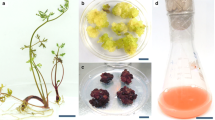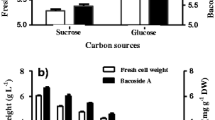Abstract
This work aimed to optimize statistically the culture medium composition for cell plant suspension culture using as a model Capsicum baccatum L. var. pendulum cells. The cell growth was maximized as well as the secondary metabolite yields with antioxidant activity, which could find applications in pharmaceutical and food industries. A Box–Behnken statistical design was utilized to optimize the basal Murashige and Skoog medium, which is widely used in plant cell culture. Three relevant ingredients, saccharose (A, 15–45 g L−1), KH2PO4 (B, 0.085–0.255 g L−1) and KNO3 (C, 0.95–2.85 g L−1) were considered. The cell growth index as well as antioxidant activity, total phenolic compounds and flavonoids from dry extracts (DE) derived of cell cultures, were determined. Growth index (GI) and flavonoids content (F) were sensitive to the changes in nutrient composition in culture medium, and they were modeled statistically according to modified quadratic (\({\text{GI}}=1.76+0.59{\text{A}} - 0.32{\text{B}} - 0.42{\text{AC}}\)) and two-factor interaction \(\left( {{\text{F}}\left( {{\text{mg of rutin}}/{\text{g DE}}} \right) = 0.88 + 0.35{\text{AC}} - 0.29{\text{BC}}} \right)\) models, respectively. Antioxidant activity and total polyphenols were independent of the nutrient concentrations within the range under study. The optimized culture medium composition was defined for two approaches: maximization of the cell growth (45 g L−1 saccharose, 0.09 g L−1 KH2PO4, 0.95 g L−1 KNO3) and maximization of flavonoids production (45 g L−1 saccharose, 0.09 g L−1 KH2PO4, 2.85 g L−1 KNO3). According to the current results, other elicitation strategies should be assessed to make this bioprocess more efficient for manufacturing secondary metabolites with antioxidant activity from suspension culture of Capsicum baccatum L. var. pendulum cells.




Similar content being viewed by others
References
Bhatia S (2015) Plant tissue culture. In: Bhatia S, Sharma K, Dahiya R, Bera T (eds) Modern applications of plant biotechnology in pharmaceutical sciences. Elsevier Inc., Waltham, pp 31–107
Blois MS (1958) Antioxidant determinations by the use of a stable free radical. Nature 181:1199–1200
Chen VCP, Tsui K-L, Barton RR, Meckesheimer M (2006) A review on design, modeling and applications of computer experiments. IIE Trans 38:273–291. https://doi.org/10.1080/07408170500232495
Costa NR, Lourenço J, Pereira ZL (2011) Desirability function approach: a review and performance evaluation in adverse conditions. Chemom Intell Lab Syst 107:234–244. https://doi.org/10.1016/j.chemolab.2011.04.004
Davies KM, Deroles SC (2014) Prospects for the use of plant cell cultures in food biotechnology. Curr Opin Biotechnol 26:133–140. https://doi.org/10.1016/j.copbio.2013.12.010
Dias MI, Sousa MJ, Alves RC, Ferreira ICFR. (2016) Exploring plant tissue culture to improve the production of phenolic compounds: a review. Ind Crops Prod 82:9–22. https://doi.org/10.1016/j.indcrop.2015.12.016
Ferri M, Gruarin N, Barbieri F, Tassoni A (2017) Capsicum spp in vitro liquid cell suspensions: a useful system for the production of capsaicinoids and polyphenols. Plant Biosyst. https://doi.org/10.1080/11263504.2017.1305998
Fidemann T, Nascimento LB, Moraes MC et al (2016) Optimizing in vitro germination of Capsicum baccatum L. seeds through a multifactorial experimental design. Am Int J Biol 4:1–22. https://doi.org/10.15640/aijb.v4n2a1
Fidemann T, de Araujo Pereira GA, Bossard Nascimento L et al (2017) Holistic protocol for callus culture optimization using statistical modelling. Nat Prod Res 6419:1–9. https://doi.org/10.1080/14786419.2017.1380026
Kehie M, Kumaria S, Tandon P (2016) Biotechnological enhancement of capsaicin biosynthesis in cell suspension cultures of Naga King Chili (Capsicum chinense Jacq.). Bioprocess Biosyst Eng 39:205–210. https://doi.org/10.1007/s00449-015-1504-6
Lannes SD, Finger FL, Schuelter AR, Casali VWD (2007) Growth and quality of Brazilian accessions of Capsicum chinense fruits. Sci Hortic 112:266–270. https://doi.org/10.1016/j.scienta.2006.12.029
Loizzo MR, Pugliese A, Bonesi M et al (2015) Evaluation of chemical profile and antioxidant activity of twenty cultivars from Capsicum annuum, Capsicum baccatum, Capsicum chacoense and Capsicum chinense: a comparison between fresh and processed peppers. LWT 64:623–631. https://doi.org/10.1016/j.lwt.2015.06.042
Maran JP, Manikandan S, Priya B, Gurumoorthi P (2015) Box-Behnken design based multi-response analysis and optimization of supercritical carbon dioxide extraction of bioactive flavonoid compounds from tea (Camellia sinensis L.) leaves. J Food Sci Technol 52:92–104. https://doi.org/10.1007/s13197-013-0985-z
Martins N, Barros L, Ferreira ICFR. (2016) In vivo antioxidant activity of phenolic compounds: facts and gaps. Trends Food Sci Technol 48:1–12. https://doi.org/10.1016/j.tifs.2015.11.008
Murashige T, Skoog F (1962) A revised medium for rapid growth and bio assays with tobacco tissue cultures. Physiol Plant 15:473–497. https://doi.org/10.1111/j.1399-3054.1962.tb08052.x
Murthy HN, Lee EJ, Paek KY (2014) Production of secondary metabolites from cell and organ cultures: strategies and approaches for biomass improvement and metabolite accumulation. Plant Cell Tissue Organ Cult 118:1–16. https://doi.org/10.1007/s11240-014-0467-7
Nicasio-Torres M, del P, Meckes-Fischer, Aguilar-Santamaría M L, et al (2012) Production of chlorogenic acid and isoorientin hypoglycemic compounds in Cecropia obtusifolia calli and in cell suspension cultures with nitrate deficiency. Acta Physiol Plant 34:307–316. https://doi.org/10.1007/s11738-011-0830-9
O’Connor SE (2015) Engineering of secondary metabolism. Annu Rev Genet 49:71–94. https://doi.org/10.1146/annurev-genet-120213-092053
Prasad BCN, Gururaj HB, Kumar V et al (2006) Valine pathway is more crucial than phenyl propanoid pathway in regulating capsaicin biosynthesis in Capsicum frutescens Mill. J Agric Food Chem 54:6660–6666. https://doi.org/10.1021/jf061040a
Ramachandra Rao S, Ravishankar GA (2002) Plant cell cultures: chemical factories of secondary metabolites. Biotechnol Adv 20:101–153. https://doi.org/10.1016/S0734-9750(02)00007-1
Rodríguez-Burruezo A, Prohens J, Raigón MD, Nuez F (2009) Variation for bioactive compounds in ají (Capsicum baccatum L.) and rocoto (C. pubescens R. & P.) and implications for breeding. Euphytica 170:169–181. https://doi.org/10.1007/s10681-009-9916-5
Schripsema J, Meijer AJ, van Iren F et al (1990) Dissimilation curves as a simple method for the characterization of growth of plant cell suspension cultures. Plant Cell Tissue Organ Cult 22:55–64
Singleton VL, Rossi JA (1965) Colorimetry of total phenolics with phosphomolybdic-phosphotungstic acid reagents. Am J Enol Vitic 16:144–158
Smetanska I (2008) Production of secondary metabolites using plant cell cultures. Adv Biochem Eng Biotechnol 111:187–228. https://doi.org/10.1007/978-3-540-70536-9
Wilson PDG (1987) On-line estimation of biomass using dynamic oxygen balancing. Biotechnol Tech 1:151–156
Wilson SA, Roberts SC (2012) Recent advances towards development and commercialization of plant cell culture processes for the synthesis of biomolecules. Plant Biotechnol J 10:249–268. https://doi.org/10.1111/j.1467-7652.2011.00664.x
Yeoman MM, Yeoman CL (1996) Manipulating secondary metabolism in cultured plant cells. New Phytol 134:553–569. https://doi.org/10.1111/j.1469-8137.1996.tb04921.x
Zhishen J, Mengcheng T, Jianming W (1999) The determination of flavonoid contents in mulberry and their scavenging effects on superoxide radicals. Food Chem 64:555–559
Zhou X, Zhong J-J (2010a) Plant cell culture, secondary product accumulation. In: Flickinger MC (ed) Encyclopedia of industrial biotechnology: bioprocess, bioseparation, and cell technology. Wiley, Hoboken, pp 3819–3883
Zhou X, Zhong J-J (2010b) Plant cell culture, secondary product accumulation. In: Flickinger MC (ed) Encyclopedia of industrial biotechnology: bioprocess, bioseparation, and cell technology. Wiley, Hoboken, pp 1–29
Zimmer AR, Leonardi B, Miron D et al (2012) Antioxidant and anti-inflammatory properties of Capsicum baccatum: from traditional use to scientific approach. J Ethnopharmacol 139:228–233. https://doi.org/10.1016/j.jep.2011.11.005
Acknowledgements
The first author would like to thank Fundação de Amparo à Pesquisa do Estado de São Paulo/Brazil (FAPESP) for Master’s fellowship (2014/26997-4) and scientific teams from Laboratório de Biotecnologia Vegetal, Laboratório de Fitoterápicos e Produtos Naturais (FITOLAB), and Laboratório de Bioprocessos (UNESP, Campus Assis). The corresponding author gratefully acknowledges his wife, Relma, and daughters, Giovanna and Paola, for the inspiration to write this manuscript.
Author information
Authors and Affiliations
Contributions
EGFN, MRB, and RMGS conceived and designed the research. TF, GAAP, TRH, and RBG conducted experiments. EGFN analyzed data statistically and wrote the first draft of the manuscript. All authors contributed to wrote the final version of the manuscript, read and approved the submitted text.
Corresponding author
Ethics declarations
Conflict of interest
All authors declare that they have no conflict of interest.
Additional information
Communicated by Sergio J. Ochatt.
Rights and permissions
About this article
Cite this article
Fidemann, T., de Araujo Pereira, G.A., Heluy, T.R. et al. Handling culture medium composition for optimizing plant cell suspension culture in shake flasks. Plant Cell Tiss Organ Cult 133, 137–146 (2018). https://doi.org/10.1007/s11240-017-1368-3
Received:
Accepted:
Published:
Issue Date:
DOI: https://doi.org/10.1007/s11240-017-1368-3




